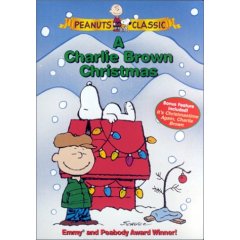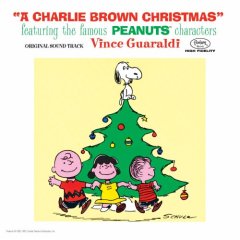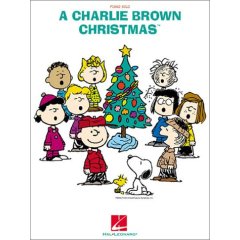


Tonight ABC will broadcast A Charlie Brown Christmas (actually this will be ABC's second broadcast). This is the best Christmas special ever. A long long time ago when there were only three networks it was teamed with How the Grinch Stole Christmas. The Grinch went first and then Charlie Brown. They were usually shown the Sunday before Christmas.
Over time the shows were not shown together. Parts of Charlie Brown were lost to make way for commericals. I remember my parents bought me the VHS tape. My friend Stuart and I eagerly watched and were surprised to see scenes on the tape that we'd not seen on TV for years.
Thankfully, when ABC got the rights to all the specials, they are now shown in their entirety. If you have a chance tune in tonight and watch. If not get the DVD and watch it.
A story on the special from last year in USA Today:
The Christmas classic that almost wasn't
 | |||
"They said it was slow," executive producer Lee Mendelson remembers with a laugh. There were concerns that the show was almost defiantly different: There was no laugh track, real children provided the voices, and there was a swinging score by jazz pianist Vince Guaraldi.
Mendelson and animator Bill Melendez fretted about the insistence by Peanuts creator Charles Schulz that his first-ever TV spinoff end with a reading of the Christmas story from the Gospel of Luke by a lisping little boy named Linus.
"We told Schulz, 'Look, you can't read from the Bible on network television,' " Mendelson says. "When we finished the show and watched it, Melendez and I looked at each other and I said, 'We've ruined Charlie Brown.' "
Good grief, were they wrong. The first broadcast was watched by almost 50% of the nation's viewers. "When I started reading the reviews, I was absolutely shocked," says Melendez, 89. "They actually liked it!"
And when the program airs today at 8 p.m. ET on ABC, it will mark its 40th anniversary — a run that has made it a staple of family holiday traditions and an icon of American pop culture. The show won an Emmy and a Peabody award and began a string of more than two dozen Peanuts specials.
Last year, 13.6 million people watched it, making it the 18th-most-popular show on television the week it aired; CSI was first. One advertiser on the show, financial services giant MetLife, has contracted to use Peanuts characters in its advertising since 1985 and will continue through at least 2012.
Schulz, who died in 2000, never doubted the power of his tale of Charlie Brown's quest for the true meaning of Christmas amid the garish trappings of a commercialized holiday. "It comes across in the voice of a child," says Jeannie Schulz, the wife of the cartoonist, whose friends called him Sparky. "Sparky used to say there will always be a market for innocence."
Peter Robbins, now 49, was the voice of Charlie Brown. "This show poses a question that I don't think had been asked before on television: Does anybody know the meaning of Christmas?"
Parents like Molly Kremidas, 39, who grew up adoring A Charlie Brown Christmas, watch it with their kids. "It's the values in the story," says Kremidas, of Winston-Salem, N.C. She'll watch tonight with daughter Sofia, 6. "Would there be any programs for children on today that could get away with talking about the real meaning of Christmas? I don't think so."
Erin Kane, 36, is eager for her 3-year-old son Tommy to watch the program for the first time tonight in their Boston home. "The Christmas season doesn't start," Kane says, "until Charlie Brown is on."
Hip but wholesome
On paper, the show's bare-bones script would seem to offer few clues to its enduring popularity. Mendelson says the show was written in several weeks, after Coca-Cola called him just six months before the program aired to ask if Schulz could come up with a Peanuts Christmas special.
Charlie Brown, depressed as always, can't seem to get into the Christmas spirit. His friend and nemesis Lucy suggests that he direct the gang's Christmas play. But the Peanuts crew is focused on how many presents they're going to get, not on putting on a show.
"Just send money. How about tens and twenties?" says Charlie's sister Sally as she dictates a letter to Santa Claus.
Charlie goes to find a Christmas tree to set the mood. He returns with a scrawny specimen that prompts his cohorts to mock him as a blockhead. In desperation, Charlie asks if anyone can explain to him what Christmas is all about.
"Sure, I can," says his friend Linus, who proceeds to recite the story of the birth of Jesus from the book of Luke in the King James Version of the Bible. "And suddenly, there was with the angel a multitude of the heavenly host praising God, and saying, 'Glory to God in the Highest, and on Earth peace, and goodwill toward men,' " Linus says. "And that's what Christmas is all about, Charlie Brown."
Scholars of pop culture say that shining through the program's skeletal plot is the quirky and sophisticated genius that fueled the phenomenal popularity of Schulz's work, still carried by 2,400 newspapers worldwide even though it's repeating old comic strips.
The Christmas special epitomizes the nostalgic appeal of holiday television classics for baby boomers raised as that medium gained prominence, says Robert Thompson, a professor of television and popular culture at Syracuse University.
Thompson notes that other Christmas specials made during the same era — such as Rudolph the Red-Nosed Reindeer and Frosty The Snowman - also air each year to strong ratings.
"This is the only time in the year when TV programs from the LBJ years play on network television and do very, very well," he says. "For millions of baby boomers, these things became as much a holiday tradition as hanging a stocking or putting up a tree."
What makes A Charlie Brown Christmas the "gold standard" in Thompson's view is that it somehow manages to convey an old-fashioned, overtly religious holiday theme that's coupled with Schulz's trademark sardonic, even hip, sense of humor.
While Schulz centers the piece on verses from the Bible, laced throughout are biting references to the modern materialism of the Christmas season. Lucy complains to Charlie that she never gets wants she really wants. "What is it you want?" Charlie asks. "Real estate," she answers.
"A key element in all of Schulz's work is his sense of man's place in the scheme of things in a theological sense as well as a psychological sense," says Thomas Inge, an English and humanities professor at Randolph-Macon College who edited a series of interviews with Schulz released in 2000. "Then there's this slightly cynical attitude that makes everything work."
Parents say the combination of humor and bedrock values is what draws them and their children to the show. "It does provide a balance, but it's a balance that we as a society have forgotten about," says Patrick Lemp, 43, of West Hartford, Conn. He'll watch tonight with son Brendan, 13.
"This is one of the last shows that actually comes out and talks about the meaning of Christmas. As a society, we're taking religion out of a lot of the trappings of the holiday. This one is different."
A cultural footprint
Much about A Charlie Brown Christmas was revolutionary for network TV, even beyond its religious themes.
The voices of children had not been used before in animation, a technique Mendelson, Melendez and Schulz all wanted to try.
"Lee didn't want to use Hollywood kids. He wanted the sound of kids who didn't have training," says Sally Dryer, 48, who did the voice of Violet — the little girl who mocks Charlie Brown for not getting any Christmas cards. In later specials, she was Lucy's voice.
Mendelson sent tape recorders home with all his employees in Burlingame, Calif. Dryer, then 8, was chosen because her sister worked for the Mendelson crew. Robbins and Christopher Shea, the voice of Linus, were the only children with professional acting experience in the cast.
The show was also novel in that it used no laugh track, an omnipresent device in animated and live-action comedies of the era. Schulz strongly believed that his audience could figure out when to laugh.
Perhaps the most enduring aspect of the show has been its score — a piano-driven jazz suite that was absolutely unheard-of for children's programming in 1965.
Guaraldi, the composer and pianist, was best known for a 1962 hit called Cast Your Fate To the Wind. Mendelson liked it so much that he hired Guaraldi to score a documentary about Schulz that never aired. When the Christmas program was sold, parts of that music were incorporated.
The driving tune that the Peanuts children keep dancing to in the special, called Linus and Lucy, has become a pop staple that's been recorded countless time in the intervening decades.
A new version of the soundtrack was released last month for the 40th anniversary. It features Vanessa Williams, Christian McBride, David Benoit and others.
The song that opens the program, Christmas Time is Here, was written only for piano by Guaraldi, but Mendelson decided to add words to appease other network concerns. When he found his songwriter friends in California were all tied up, Mendelson wrote the words himself on the back of an envelope.
"So now it's a standard," says Mendelson, now 72. "Who knew? I tell people that I'm old and I'm lucky."
Jazz pianist George Winston, recorded a 1996 tribute album to Guaraldi, who died in 1976. He says that when he plays Guaraldi tunes at concerts, young children come up later and say, "Hey, that's the Peanuts music!"
Says Winston: "Vince made a stamp on our popular culture that will never go away. For an artist, that's the ultimate tribute."
A sweet memory
The Christmas special has become a key part of the Peanuts marketing empire, which racks up $1.2 billion in annual retail sales, $350 million of which come in the USA. Millions of VCR tapes and DVDs of the program are in circulation worldwide.
The 40th anniversary has spawned a long list of spinoff products, including a "Charlie Brown Christmas Tree" at Urban Outfitters and a paperback version of a book Mendelson wrote, The Making of a Tradition: A Charlie Brown Christmas. And the Charles Schulz Museum in Santa Rosa, Calif., where Schulz lived, plans a special commemoration on Dec. 17 with Mendelson and several cast members. The museum also has an exhibit on the Christmas show that runs through Jan. 9.
"It's a tradition, along with White Christmas, A Christmas Carol and It's a Wonderful Life," says Marion Hull, 77, who toured the exhibit on Friday. "It's simple, it tells a simple story, and it's something that both adults and children can get something out of."
For those who worked to make the program — as well as fans who watch it — its material success seems ancillary. The word that keeps coming up is "sweet."
Robbins, who is single, has no children and manages an apartment building in Encino, Calif., loves that kids of friends squeal with delight each Christmas that "Uncle Pete used to be Charlie Brown."
Jeannie Schulz, who was the artist's second wife when they married in 1973, says their five children, 25 grandchildren and two great-grandchildren see the show as a holiday tradition as well.
"The reason it's endured is because of its simplicity and its very basic honesty to real life," she says. "Who would have thought this would last 40 years? How did that happen?"
For many viewers, it is the speech by Linus from Luke near the end that packs the biggest emotional wallop.
Christopher Shea was just 7 when he did the part and credits Melendez's coaching and his mom's doctorate in 17th-century British literature for Linus' lilting eloquence with a Biblical text.
Shea, who now lives in Eureka, Calif., with two daughters, 11 and 16, answers quickly when asked why the special has proved so enduring. "It's the words," he says.
Shea says that for years, in his teens and 20s, he didn't quite understand his soliloquy's impact.
"People kept coming up to me and saying, 'Every time I watch that, I cry,' " he says. "But as I got older, I understood the words more, and I understood the power of what was going on. Now I cry, too."
Contributing: Editor's note: USA TODAY reporter Bill Nichols first watched A Charlie Brown Christmas on Dec. 9, 1965. He was 7. This Thanksgiving, he watched a tape of it with his son, Charlie, 3, for the first time.
3 comments:
I dunno, I think it's more of a trifecta of Christmas specials--this one, the Grinch and "Rudolph the Red Nosed Reindeer". I think I was probably a resident on the Island of Misfit Toys.
I especially remember the triple header commercials that ran during "Rudolph," with some of the characters from the show and Santa riding a shaver. "Noelco," the commercial said, "Even our name says 'Merry Christmas.'"
For me the whole season started with "It's The Great Pumpkin, Charlie Brown". Sigh! Nostalgia can be so depressing. I wonder if the doctor is "Real In". Probably more than 5 cents, too, after 40 years of inflation.
I dunno, I think it's more of a trifecta of Christmas specials--this one, the Grinch and "Rudolph the Red Nosed Reindeer". I think I was probably a resident on the Island of Misfit Toys.
I especially remember the triple header commercials that ran during "Rudolph," with some of the characters from the show and Santa riding a shaver. "Noelco," the commercial said, "Even our name says 'Merry Christmas.'"
For me the whole season started with "It's The Great Pumpkin, Charlie Brown". Sigh! Nostalgia can be so depressing. I wonder if the doctor is "Real In". Probably more than 5 cents, too, after 40 years of inflation.
Post a Comment